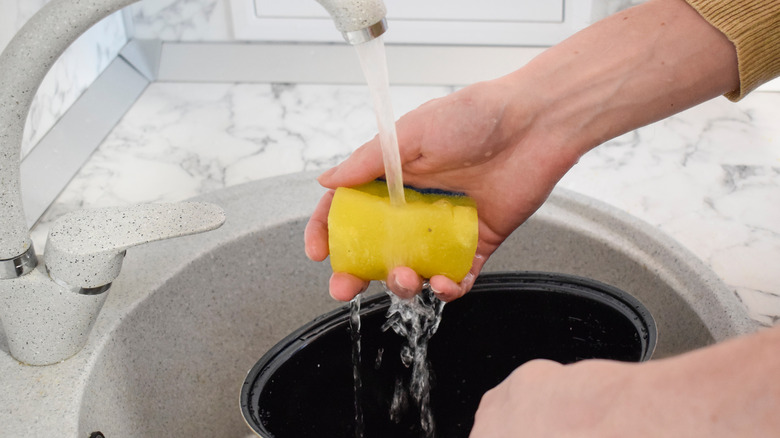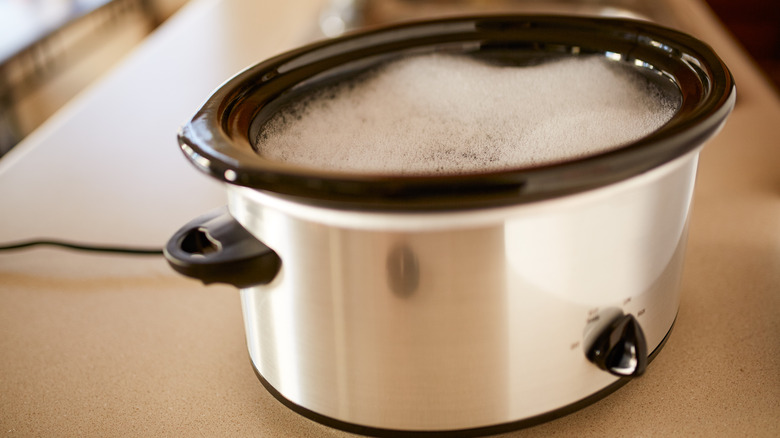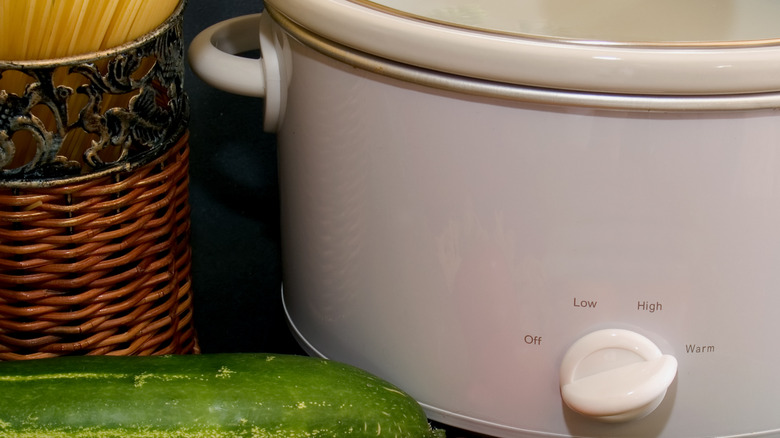The Best Way To Clean Your Crusty Crock Pot So It Looks Brand New
Crock-Pot cooking offers convenience, but cooking food for hours means residue can become hard, dried on, and tough to remove. Over time, this residue can build up on your Crock-Pot stoneware or the heating base. Fortunately, it's not impossible to clean, and you probably already have all the Crock-Pot cleaning tools you need in your kitchen. Here's how you can keep your Crock-Pot clean and ready to cook.
Washing a Crock-Pot after regular use is simple: You'll need to clean it quickly with dish soap or put it in the dishwasher if you prefer not to hand wash. Use these tips to make cleaning up after a Crock-Pot meal easy. As with any cookware cleaning, the sooner you clean it, the better. Letting food sit in your stoneware only gives it a chance to dry out and harden, which makes it more difficult to clean. Once you're done with your meal, remove any leftovers and start cleaning. If you can't get to it immediately, fill your Crock-Pot stoneware with water and dish soap and let it sit. That way, food can't dry out below the waterline. Plus, the soap can work away at the food until you're ready to clean.
Crock-Pot stoneware is sensitive to sudden temperature changes. For example, if you fill a hot Crock-Pot with cold water, it may crack. Let your stoneware cool down before cleaning it in cold water, or wash a hot Crock-Pot with hot water to keep the temperature consistent.
Other ways to clean your Crock-Pot
Dish soap, vinegar, or baking soda used with a soft cloth or sponge should be able to handle Crock-Pot messes. Avoid using a scouring pad or abrasive cleaners, which can scratch and wear away the finish of your stoneware pot. Crock-Pot stoneware is dishwasher safe, so you can put the pot and lid in your dishwasher after rinsing. Crock-Pot liners are available and can prevent messes and stains in your stoneware. When you use a liner, you can throw it away after use — and don't need to worry about cleaning. However, not all cooks are comfortable using liners. Some believe it takes away from the flavor of slow cooker dishes.
On occasion, your Crock-Pot may need a deep cleaning. When it's time to deep clean, your Crock-Pot can help clean itself like it cooks: with heat and time. First, fill your Crock-Pot with water over the residue line. Add vinegar (½ cup for a 3-quart slow cooker, or 1 cup for a 6-quart slow cooker), then introduce baking soda incrementally (½ cup for a 3-quart slow cooker, or 1 cup for a 6-quart slow cooker.)
Afterward, cover your slow cooker, set it to low, and leave it for at least an hour. Allow the Crock-Pot to cool down, then wash it in your sink or dishwasher. For stubborn residue not removed by this process, you can make a dense paste of baking soda and lemon juice, then scrub it with a soft cloth.
How to clean your Crock-Pot's base
Crock-Pot stoneware is where most of the mess happens, but food can get on your Crock-Pot's heating base, which is usually metal and less easy to clean than stoneware. While the stoneware is safe to put in your sink or dishwasher, its base is not dishwasher-safe.
The first thing you should know about cleaning your Crock-Pot heating base is what not to do: Don't immerse the heating base in water or any other liquid. Unlike the stoneware, the heating base is an electrical appliance and, thus, dangerous when immersed in water — even when it's not plugged in. Like the stoneware, your Crock-Pot's base should never be cleaned with abrasive products or scrubbers.
As with stoneware, cleaning messes quickly is a key to keeping your Crock-Pot base clean. Baked-on stains become stubborn, so you'll want to wipe up messes before they become stains. After each use, allow the heating base to cool down, then use a soft cleaning cloth, sponge, or rubber spatula and a small amount of soapy water to wipe it down. For more stubborn stains, spray a non-abrasive cleaning product on the area, let it sit, then wipe it down. A vinegar solution or paste of baking soda and lemon may also help with old, baked-on stains.


